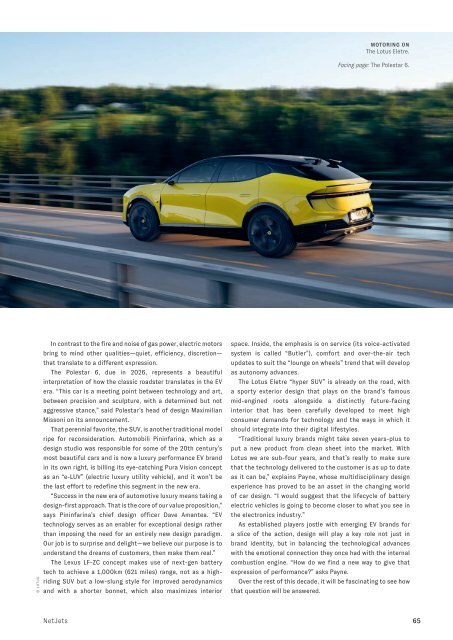Netjets US Winter 2023
- No tags were found...
You also want an ePaper? Increase the reach of your titles
YUMPU automatically turns print PDFs into web optimized ePapers that Google loves.
MOTORING ON<br />
The Lotus Eletre.<br />
Facing page: The Polestar 6.<br />
© LOT<strong>US</strong><br />
In contrast to the fire and noise of gas power, electric motors<br />
bring to mind other qualities—quiet, efficiency, discretion—<br />
that translate to a different expression.<br />
The Polestar 6, due in 2026, represents a beautiful<br />
interpretation of how the classic roadster translates in the EV<br />
era. “This car is a meeting point between technology and art,<br />
between precision and sculpture, with a determined but not<br />
aggressive stance,” said Polestar’s head of design Maximilian<br />
Missoni on its announcement.<br />
That perennial favorite, the SUV, is another traditional model<br />
ripe for reconsideration. Automobili Pininfarina, which as a<br />
design studio was responsible for some of the 20th century’s<br />
most beautiful cars and is now a luxury performance EV brand<br />
in its own right, is billing its eye-catching Pura Vision concept<br />
as an “e-LUV” (electric luxury utility vehicle), and it won’t be<br />
the last effort to redefine this segment in the new era.<br />
“Success in the new era of automotive luxury means taking a<br />
design-first approach. That is the core of our value proposition,”<br />
says Pininfarina’s chief design officer Dave Amantea. “EV<br />
technology serves as an enabler for exceptional design rather<br />
than imposing the need for an entirely new design paradigm.<br />
Our job is to surprise and delight—we believe our purpose is to<br />
understand the dreams of customers, then make them real.”<br />
The Lexus LF-ZC concept makes use of next-gen battery<br />
tech to achieve a 1,000km (621 miles) range, not as a highriding<br />
SUV but a low-slung style for improved aerodynamics<br />
and with a shorter bonnet, which also maximizes interior<br />
space. Inside, the emphasis is on service (its voice-activated<br />
system is called “Butler”), comfort and over-the-air tech<br />
updates to suit the “lounge on wheels” trend that will develop<br />
as autonomy advances.<br />
The Lotus Eletre “hyper SUV” is already on the road, with<br />
a sporty exterior design that plays on the brand’s famous<br />
mid-engined roots alongside a distinctly future-facing<br />
interior that has been carefully developed to meet high<br />
consumer demands for technology and the ways in which it<br />
should integrate into their digital lifestyles.<br />
“Traditional luxury brands might take seven years-plus to<br />
put a new product from clean sheet into the market. With<br />
Lotus we are sub-four years, and that’s really to make sure<br />
that the technology delivered to the customer is as up to date<br />
as it can be,” explains Payne, whose multidisciplinary design<br />
experience has proved to be an asset in the changing world<br />
of car design. “I would suggest that the lifecycle of battery<br />
electric vehicles is going to become closer to what you see in<br />
the electronics industry.”<br />
As established players jostle with emerging EV brands for<br />
a slice of the action, design will play a key role not just in<br />
brand identity, but in balancing the technological advances<br />
with the emotional connection they once had with the internal<br />
combustion engine. “How do we find a new way to give that<br />
expression of performance?” asks Payne.<br />
Over the rest of this decade, it will be fascinating to see how<br />
that question will be answered.<br />
NetJets<br />
65

















